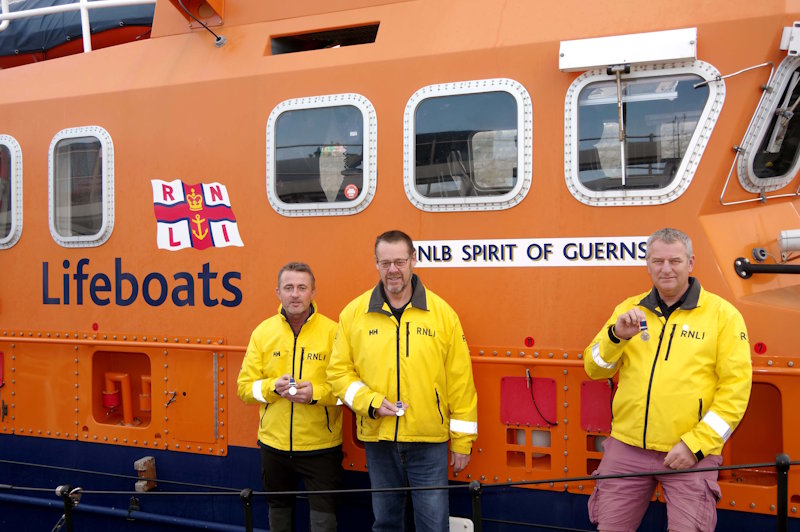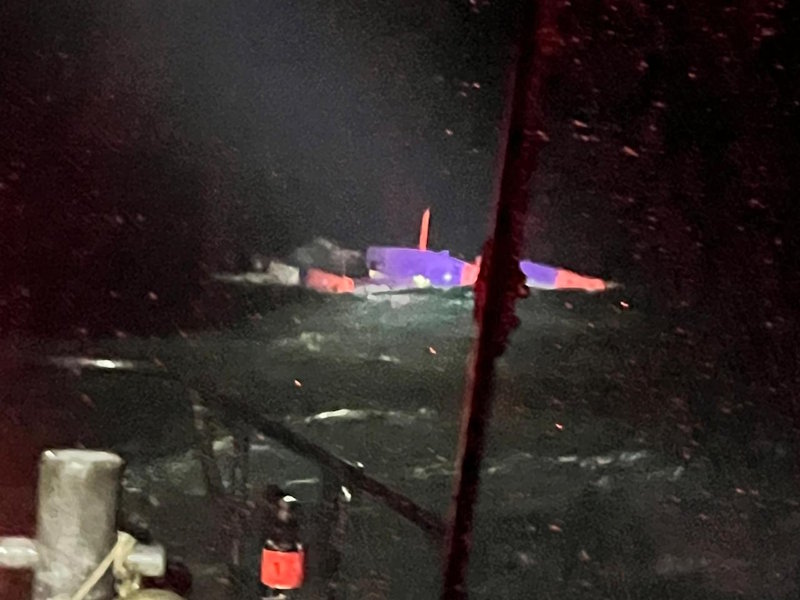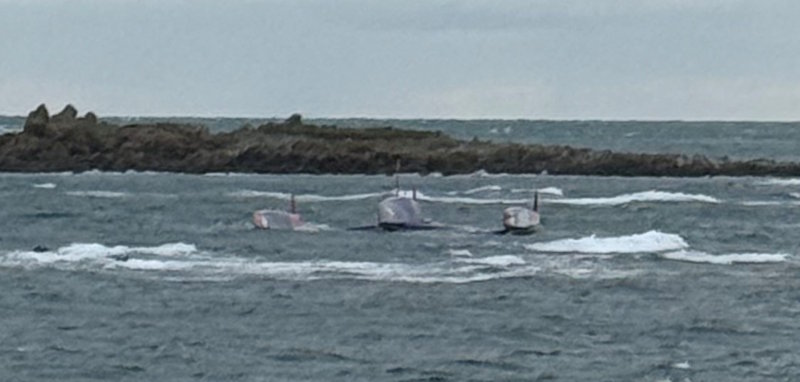30 years Service Medals were awarded to Carl Bisson, John Le Tissier and Robert Alder. 20 years Service Medal was awarded to Danny Blake.

Photo by Tony Rive

At approximately 0040 hours on Sunday 26 October, Guernsey Coastguard received an emergency beacon alert indicating a vessel in distress north of Guernsey. This was swiftly followed by a call from Joburg Maritime Rescue Coordination Centre (MRCC), reporting that a 60-foot trimaran participating in an organised race had capsized with two people on board approximately 3.5 miles northwest of Guernsey.
Guernsey Coastguard immediately contacted another yacht in the vicinity, also participating in the race, which confirmed witnessing the capsize. However, due to adverse conditions, the vessel was unable to approach or render assistance.
At 0051 hours, Guernsey Coastguard paged the St Peter Port Lifeboat for immediate launch and coordinated with Joburg MRCC, which dispatched a French rescue helicopter to the scene.
Further updates confirmed that the two sailors aboard the trimaran were uninjured and remained with the vessel. The French helicopter arrived at approximately 0130 hours, followed shortly by the St Peter Port Lifeboat. The two sailors were winched aboard the helicopter and transported to France for precautionary medical checks.
The lifeboat remained on scene to monitor the drift of the upturned vessel before returning to St Peter Port at 0230 hours. Race officials are currently arranging for the recovery of the trimaran and are tracking its drift along the west coast.
Duty SAR Mission Coordinator Simon Granger commented: “This was an organised race and the swift rescue of the two sailors is testament to the onboard safety equipment alerting the emergency services to the incident, along with the rapid response of the RNLI and French Rescue Helicopter. The joint coordination between Joburg MRCC and Guernsey Coastguard ensured a successful outcome.”

Update: Following the earlier incident involving a capsized yacht, which resulted in the successful airlift rescue of two individuals in the early hours of this morning, the vessel has now washed ashore as predicted by drift modelling.
The yacht has come to rest at the southern end of Perelle Bay, near the Shingle Bank.
Guernsey Coastguard is currently coordinating with the Joint Emergency Control Centre, States Works, and the race directors in France to ensure the safe removal of the vessel from the shoreline.
At this time, the pollution risk has been assessed as minimal. The situation continues to be closely monitored.
Members of the public are kindly requested to stay clear of the vessel, particularly as the tide drops, to allow recovery teams to work safely and efficiently.


Over the next three years, RNLI lifeboat crews in Alderney, St Peter Port and St Helier will receive the newest, state of the art, modern Shannon class all weather lifeboat which will replace each station’s current all weather lifeboat. The changes will allow RNLI lifeboat crews to respond effectively to the changing way people and visitors to the Islands are using the water and save the greatest number of lives in the most effective way.
The Shannon is the latest class of all-weather lifeboat in the RNLI fleet. Designed entirely in house by a team of RNLI engineers and built at the RNLI’s all weather lifeboat centre in Poole, Dorset, the Shannon includes the very latest in lifesaving technology, including enhanced navigation tools which allows each crew member access to navigational and systems information from any position within the wheelhouse.
St Peter Port’s current all weather Severn class lifeboat Spirit of Guernsey (ON1203) will change to a Shannon class all weather lifeboat towards the end of 2027
Alongside the all-weather lifeboat changes which are part of the wider lifeboat fleet strategy, the current Atlantic 85 inshore lifeboat at St Peter Port will be modernised to better support the volunteer crew.
At approximately 08:35 BST on Saturday, 23 August 2025, Guernsey Coastguard received a report from a local vessel that another craft was stuck on rocks just outside Bordeaux Harbour.
Upon speaking with the reporting vessel, Coastguard officers determined that the grounded vessel was in need of immediate assistance, with several people still on board. The St Peter Port Lifeboat was paged at 08:40.
Shortly after, the casualty vessel itself issued a Mayday call to Guernsey Coastguard, confirming that six people were on board and required urgent assistance. Coastguard officers maintained communication with the vessel, confirmed there were no injuries, and informed the crew that rescue efforts were underway.
The St Peter Port Inshore Lifeboat launched at 08:53 and arrived on scene at 08:59. All six individuals were safely transferred to the lifeboat and landed at St Sampson’s Harbour by 09:05.
Following the successful evacuation, the lifeboat returned to the casualty vessel, which was at risk of shifting from the rocks due to the falling tide. The Sarnia workboat was also alerted and dispatched to provide assistance.
As the tide receded, a tow line was established at 10:20. The vessel was successfully pulled from the rocks, and personnel were placed aboard to assess any damage. The vessel was then towed into St Sampson Harbour, where it was handed back to its owner.
Duty SAR Mission Coordinator (SMC) Simon Granger said: “ This was a successful outcome with no injuries, I would like to thank the reporting vessel who called the Coastguard in a timely manner and then remained on scene keeping a watch on the casualty until the lifeboat arrived. I would also like to thank the crews of the St Peter Port Lifeboat, and the team onboard the Sarnia workboat for their swift, professional, and coordinated response”.
At 3:35am on Friday 1st August 2025, Guernsey Coastguard received a broken MAYDAY call from a sailing vessel approximately 15 miles northwest of Guernsey.
Communications were poor but another vessel in the area was able to relay messages from the casualty. It was quickly established that a 72-year-old male from the sailing vessel had entered the water and could no longer be seen.
St Peter Port Lifeboat and Channel Islands Air Search were alerted and launched on service. A French Rescue helicopter was also requested from the French Coastguard.
Once on scene, Air Search located an object in the water and directed the Lifeboat to investigate. The object was found to be a man overboard marker which had been deployed by the casualty vessel shortly after the person entered the water. A search was commenced from this marker position and the casualty was located by the Lifeboat at 5:45am. Once recovered from the water, the casualty was winched onboard the French Rescue helicopter for transfer to Cherbourg Hospital. He was later pronounced deceased.
Acting Harbour Master James Way said: “I would like to praise the efforts of the search and rescue crews during this incident and our thoughts are with the family and friends of the deceased at this difficult time”.